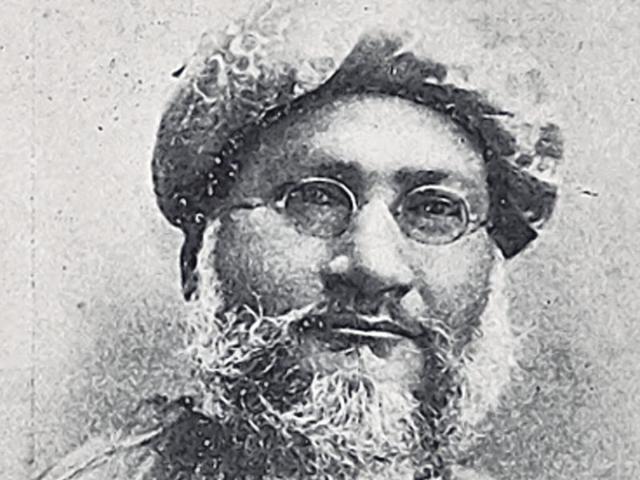Mumbai (formerly Bombay), MAHARASHTRATA / and all over India :
Some months ago I was in Kolkata when news came of the death of Laeeq Futehally, a writer and critic I greatly admired.

Some months ago I was in Kolkata when news came of the death of Laeeq Futehally, a writer and critic I greatly admired. The friend I was with hadn’t heard of her, so I spoke at some length of Laeeq’s own work (as literary editor of the pioneering journal Quest, and as the author of many books on varied subjects), and of the larger family to which she belonged. ‘Laeeq was a Tyabji,’ I told my friend, ‘and you can think of the Tyabjis as being the Tagores of Western India — a family of men and women of real distinction in the arts and public life’.
A look of disbelief now came over my friend’s face. For which Bengali can countenance a comparison to the Tagores? I pressed on, offering some names in illustration. The first great Tyabji was Badruddin, a judge of the Bombay High Court and an early president of the Indian National Congress. Direct descendants of Badruddin included the tennis player and legal scholar AA Fyzee (author of landmark studies on Islamic law), the politician and social reformer Saifuddin Tyabji, the conservationist Zafar Futehally, and Badruddin Tyabji Jr., a distinguished Indian diplomat and author.
My friend Laeeq Futehally was herself a descendant of Badruddin’s elder brother Shumsuddin Tyabji. Shumsuddin’s only son was Abbas Tyabji; once Chief Justice of Baroda State, he later joined the freedom struggle, being appointed leader of the Salt Satyagraha after Gandhi’s arrest. A nephew of Abbas (and grandson of Shumsuddin) was the great ornithologist Salim Ali, the author of landmark studies of Indian birds and an inspirational figure for conservationists all over the world.
The women of the Tyabji family were likewise quite remarkable. A fine study by the late Salima Tyabji (see http://cinnamonteal.in/authors/salima-tyabji/) narrates how they were the first Muslim women in Western India to emerge out of purdah, to travel overseas, to go to school and college, and to write at length of their experiences. Later generations kept the family name flying. Among Abbas Tyabji’s daughters was the formidable women’s rights activist Sharifa Hamid Ali and the mystic and Meera bhajan singer Raihana Tyabji.
Such was the background to the comment I made about the Tyabjis in Kolkata, a comment that evoked dismay bordering on disgust. But I have since found confirmation of the validity of my comparison. Reading through Gandhi’s Collected Works, I came across a letter written by him to Abbas Tyabji on the 17th April 1920. Here Gandhi says: ‘Indeed the Tagores and the Tyabjis are the rarities for India and they are her friends’.
The contributions of the Tagores are of course colossal, as well as colossally well known. The most famous of the Tagores was Rabindranath: poet, novelist, playwright, composer, artist, institution builder, the first Asian to win a Nobel Prize, and one who profoundly influenced both Gandhi and Nehru.
Rabindranath was a giant who looked farther in part because he stood on the shoulders of those who preceded him. His grandfather, Dwarkanath, was a successful entrepreneur whose wealth laid the basis for the artistic pursuits of his descendants. His father, Debendranath, was a progressive reformer and editor.
Rabindranath’s gifted siblings included the scholar and composer Dwijendranath, the actor and translator Jyotindranath, the singer, editor and social worker Swarnakumari, and Satyendranath, the first non-white member of the Indian Civil Service.
The generation that followed was also not lacking in talent. Rabindranath’s nephews included the modernist painters Abanindranath and Gaganendranath. His nieces included Sarala Devi, a singer, writer and patriot who so entranced Gandhi that he at one stage intended to make her his ‘spiritual wife’.
Which was the greater of the two families, the Tagores or the Tyabjis? Rather than answer the question, let me introduce a third and scarcely less gifted family.
These were the Sarabhais of Ahmedabad. The patriarch, Ambalal, was a textile millowner and philanthropist who was an early supporter of Mahatma Gandhi. When, in 1915, Gandhi’s funders withdrew support because he had admitted an ‘Untouchable’ family into his ashram, Ambalal Sarabhai stepped in to save the project.
Ambalal’s sister Anasuya was herself very close to Gandhi. A pioneering feminist and trade unionist, she ran schools for millworkers and their children. In 1918 she led the workers of Ahmedabad in a strike for fair pay that pitted her directly against her brother, who was representing the millowners.
Anasuya never married, although, in a daring defiance of custom and convention, she had a live-in partner, a fellow Gandhian and trade unionist, Shankerlal Banker.
As for Ambalal Sarabhai, he had seven children — all were talented, and at least four were remarkable. These were Vikram, the polymath physicist who founded both the Indian Institute of Management in Ahmedabad and the Indian Space Research Organisation; Mridula, who worked heroically to settle post-Partition refugees and, later, to bring justice to the Kashmiris and their leader Sheikh Abdullah (who had been incarcerated by the Nehru government); Gautam, a public-spirited entrepreneur who founded the National Institute of Design (NID); and Gira, a brilliant designer who assisted her brother in shaping the NID while also setting up the Calico Textile Museum.
Had Gandhi had the opportunity, he might well have added the Sarabhais to the Tagores and the Tyabjis as among the ‘rarities of India’. These three families had several things in common: the ability to defy social boundaries as well as transcend disciplinary boundaries, an apparently unending stream of creativity, and the striking independence of their women. A single column can scarcely do justice to their talents and achievements. While the Tagores have had their chroniclers, the Tyabjis and Sarabhais still await theirs.
Ramachandra Guha’s most recent book is Gandhi Before India
You can follow him on Twitter at @Ram_Guha
The views expressed by the author are personal
source: http://www.hindustantimes.com / Hindustan Times / Home> Opinion / by Ramchandra Guha / April 11th, 2015









